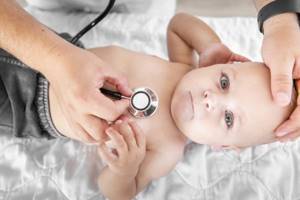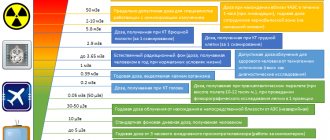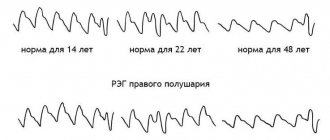The children's medical center conducts neonatal screening in the laboratory of the Morozov Children's City Clinical Hospital.
Newborn screening allows you to identify a number of serious hereditary diseases that cannot be determined in utero, but must be excluded after birth in order to avoid severe complications, as well as disability and death.
The essence of screening is that diseases that are quite common in the population are identified, the success of treatment of which depends entirely on the early initiation of therapy. In the treatment of these conditions, time and a competent approach play a decisive role.
According to Order No. 185 of the Ministry of Health and Social Development of the Russian Federation dated March 22, 2006 “On mass screening of newborn children for hereditary diseases,” newborn screening is carried out for 5 hereditary diseases:
- Adrenogenital syndrome is a disease characterized by a violation of the production of hormones by the adrenal cortex, while an excess of sex hormones and glucocorticoids is formed in the body. This causes a sharp disruption of salt metabolism, impaired growth and abnormal development of the genital organs.
- Congenital hypothyroidism is a disease based on complete or partial deficiency of thyroid hormones, which leads to disruption of the development of all organs and systems.
- Galactosemia , a disease based on a gene mutation, consists of a lack or absence of enzymes for converting galactose contained in milk into glucose. Galactose does not undergo fermentation, but accumulates in the body, causing a strong toxic effect on the central nervous system, liver and visual apparatus.
- Phenylketonuria is a disease in which the production of the enzyme that breaks down the amino acid phenylalanine, which is part of most protein products, is reduced or completely absent. Without being broken down, this amino acid and its derivatives accumulate in the body and, at a certain point, become extremely toxic and affect the child’s nervous system.
- Cystic fibrosis is a systemic hereditary disease based on a gene mutation, characterized by severe disorders in the respiratory and digestive organs.
What types of blood tests are there and what are they for?
Blood test in newborns
– prescribed for children from 3 months. Goal: to exclude the development of iron deficiency anemia and check whether the baby is ready for routine vaccinations. If there is the slightest deviation from the norm in the blood test, children are not vaccinated. If there is a hereditary predisposition to certain diseases, a special genetic blood test is performed.
Clinical (general) blood test in children
– the most common blood test. Purpose: to identify inflammatory processes in the body, anemia, the presence of worms, endocrine disorders (ESR). Prescribed to determine/confirm the diagnosis, adjust treatment, and prevent diseases (primarily infectious).
Blood chemistry
– a more detailed study that gives an idea of the state of various organs and systems of the body. It is taken only from a vein.
If necessary, some medical specialists can provide a referral for a blood test for allergens or hormones.
Pathophysiology and risk factors
There are a number of perinatal and obstetric factors that increase the risk of neonatal sepsis. This is premature rupture of membranes (or PROM), the symptoms of which appear approximately 17-18 hours before the baby is born. Maternal chorioamnionitis is also a risk factor. It can begin both during childbirth and shortly before it - with symptoms of maternal leukocytosis, soreness of the uterus, discharge with an unpleasant odor and tachycardia. When colonized with B-staphylococci, the risk of sepsis increases several times.
It is known that mothers who have a low density of colonization with group B staphylococci often give birth to children whose colonization, on the contrary, has a high density. Amniotic fluid contains meconium and lubricant. Their environment provokes intensive growth and development of microorganisms (in particular, different types of streptococci). If premature rupture of the fetal membranes occurs, pathogenic microflora begins to multiply intensively. Aspiration allows it to enter the child’s bloodstream, resulting in rapid development of bacteremia.
In case of late onset of neonatal sepsis, labor that began prematurely should be noted as the main risk factor. Other factors include the use of intravascular catheters, the presence of associated pathologies, the effect of certain antibacterial drugs and prolonged hospital stay.
Gram-positive types of staphylococci enter the child’s body from the external environment or from the skin. Gram-negative Escherichia coli, as a rule, is found in the endogenous microflora and begins to manifest itself under conditions of changes in the internal environment of the body: for example, the microflora can change when taking antibiotics or the ingress of resistant bacteria. Resistant bacteria can end up inside a child’s body in at least two ways:
- through contaminated medical equipment;
- through the hands of medical personnel due to poor quality treatment.
Fungal flora, which contributes to the development of sepsis, enters the bloodstream with prolonged use of central catheters, as well as with regular overfeeding and the use of certain cephalosporin antibiotics.

What happens to the baby in the treatment room?
A calm, positive atmosphere reigns in the treatment room of our center. Moms and dads have the opportunity to come in with the baby and, during blood sampling, hold him on their lap, hug, kiss, and blow in his ear. The child's attention will be distracted by funny pictures on the walls and bright toys. We do everything to make sure that the children have a pleasant and pain-free experience. For example, instead of conventional scarifying needles to take blood from a finger, we use an expensive new product - lancets . These funny devices, similar to a fountain pen, with a button and a spring, are very popular with little patients. The needles in the lancets have a special sharpening: they pierce the skin almost painlessly and so that the blood flows quickly and you don’t have to press on the finger for a long time. At the end of the procedure, the doctor seals the wound with a plaster with funny faces or animals.
Many mothers are wary of taking blood from a vein. And in vain! Our center employs an experienced procedural doctor who will perform all the necessary manipulations quickly and comfortably for the baby. In winter, for example, this method is preferable: blood will flow from a vein faster than from a cold finger, which means that the baby will have fewer reasons for dissatisfaction.
Newborn genetic screening
Recently, technologies in the field of genetics are developing so quickly that not only gene therapy for most diseases is just around the corner, but also the possibility of studying the genome of a specific living person.
On the one hand, this will make it possible to foresee the development of certain diseases in early childhood, long before the first signs of pathology appear. On the other hand, is it necessary to do this? Does the patient really need this? How necessary is it to study the genome of a newborn if there is no visible indication for it?
Ethics in medicine
First of all, if we are talking about ethics, we need to understand what ethics is in relation to medicine. Its basic principles were formulated a long time ago by Hippocrates, an ancient Greek scientist who is called the father of medicine. By taking the Hippocratic Oath, the doctor promises not to harm the patient, undertakes to help him and put his interests in the aspect of recovery above all else. Doctors are still guided by these and some other principles to this day, regardless of their specialty.
Read also: Why donate cord blood
Geneticists, like other medical specialists, work in the interests of the patient, and if this is a newborn, then it is his interests that should come to the fore. However, a newly born person cannot speak on his own behalf; his parents do this for him, often complementing or even replacing the child’s interests with their own.
Most likely, fearing for his life and health, they will advocate for complete genetic screening of their son or daughter in any case - so that they know what they and the child will face in life. But how necessary is this?
No screening required
This raises a complex question that is causing heated debate among doctors and scientists. Yes, technology now makes it possible to study the genome, at least partially. Yes, the information obtained in this way can be useful both for the child himself and for his parents (there is no point in considering a newborn separately from the people with whom he is in close contact). Yes, in some cases, genetic data will help, if not prevent the development of the disease, then at least slow it down. Some experts think so.
Other experts object: complete genome sequencing will provide geneticists with a huge amount of data, from which it will be extremely difficult to isolate the truly significant ones. Some part of the information will be completely useless, and it is not a fact that important information will not be lost in this part. In addition, money will be spent on obtaining the above useless information, which could be spent on things that are more necessary for the same newborns, in particular, to combat postpartum depression in their mothers.
Another important point is the relevance of the data obtained here and now, the ability to transform the information received into actions to prevent a particular misfortune. It is absolutely not necessary that such actions can be taken immediately after birth, which means months and years of waiting, stress, anxiety and other mental problems, which, as has been repeatedly proven, affect the well-being of the child.
Experts' opinion
Scientists from the Hastings Center (a bioethics research institute located in the United States) and the University of California have been conducting research in the field of “widespread” genetic screening of newborns for 4 years. They said that genomic research is a powerful tool, but the data it provides is still not fully understood and has not been proven to contribute to people's health (except in specific situations).
In their report entitled “The Ethics of Sequencing Newborns: Recommendations and Reflections,” they noted that a targeted study of newborns at risk would be much more effective in all respects, and that total screening of the entire population is overkill. Parents, according to scientists, should be dissuaded from genome research if their child does not have indications for this (i.e., suspicion of any disease), since the conflicting information received will provoke stress and force people to spend money on unnecessary examinations.
Similar results were previously obtained by other scientists (also from the USA). In 2014, an article “Addressing the ethical challenges in genetic testing and sequencing of children” was published, in which the authors pointed out that screening of newborns requires prerequisites - any symptoms that indicate the likelihood of the existence of a particular disease. Otherwise, you should refrain from testing at least in childhood - the child will grow up and figure it out on his own.
Ksenia Yakushina
Photo depositphotos.com
How to properly take blood tests in children?
Doctors almost always ask you to take a blood test in the morning and on an empty stomach . This is not a whim, but a necessity. The fact is that blood taken from the same child at different times of the day may differ in indicators. After eating, the level of leukocytes increases, and after sleep, the level of red blood cells increases. If several blood tests are performed during the treatment period, it is important to perform them under the same conditions: take blood only from a vein or only a finger and at approximately the same time.
Causes of neonatal sepsis
Depending on the nature and onset of the course, the following types of sepsis in newborns are distinguished:
- early (develops three days after birth);
- late (appears later than three days after the birth of the child).
The cause of sepsis, which has an early onset, is pathogenic microorganisms that can enter the child’s body during childbirth. Most babies develop symptoms six hours after they are born, and most infections are caused by B-streptococci and E. coli. They are identified during cultural examination of smears taken from 35% of women.
In addition to B-streptococcus and Escherichia coli, neonatal sepsis can also be caused by:
- Klebsiella;
- enterococci;
- listeria;
- D-streptococci, etc.
If sepsis has a late onset, this means that the pathogen enters the child’s body from the external environment - in particular, due to a nosocomial infection. From 30 to 60% of clinical cases of sepsis are caused by staphylococci that penetrate intravascular devices. Most often we are talking about a central vascular catheter. E. coli can also cause late-onset sepsis, especially if the baby is born with critically low body weight.
Separately, fungal infections should be highlighted, which are one of the possible causes of the development of late sepsis. Sepsis of newborns of fungal etiology occurs in 12-18% of children with low body weight.
Free consultation on training issues
Our consultants are always ready to tell you about all the details!
Blood test norms for children
Children's blood test results differ significantly from adults. Moreover, they change every month, even week, especially in the first time after the birth of the baby. And many laboratories still print “adult” numbers on forms. And mothers clutch at their hearts when they discover that hemoglobin is elevated and leukocytes are off the charts. Don’t rush to run for valerian, but just call your pediatrician or come to his appointment. He knows the exact blood test standards for children of every age and will be able to correctly decipher the data obtained. For example, he will tell you that a baby is born with a huge amount of hemoglobin and red blood cells in the blood. Some red blood cells soon disintegrate, causing physiological jaundice in newborns. And this is a completely natural process, most often not requiring medical intervention. But if a child’s hemoglobin has increased during illness, this is a reason not to rejoice, but to urgently give the baby plenty of fluids.
Almost every second newborn baby has physiological jaundice - this is not a dangerous phenomenon. However, the skin of babies can turn yellow for another reason - due to the so-called hemolytic disease of newborns, the consequences of which are often much more serious. If your baby has been diagnosed with this, do not despair! With timely medical care, all processes in his small body will quickly return to normal and the risk of damage to the nervous system will be eliminated. To understand what the consequences of hemolytic disease will be, you first need to understand what this disease is and why it urgently needs to be treated. Let’s look at the example of hemolytic disease of newborns with group incompatibility, because it occurs more often and is somewhat easier than with Rh conflict. In this case, the mother has the first blood group 0 (I), and the fetus has another, usually the second A (II) or the third B (III). The basis of this disease is the massive breakdown of the fetus’s red blood cells due to the incompatibility of its blood and the mother’s blood. “Hemolysis” translated from Latin means destruction. The expectant mother, having the first blood group, has no antigens. Let’s denote the mother’s body in the picture with a “minus” sign. And the future child, i.e. the fetus has a second blood group, i.e. there is an antigen in his blood. In the picture, we will denote the fetus with a “plus” sign. If the fetus has an antigen, the mother’s immune system will begin to consider this antigen as a foreign enemy agent and will begin to produce protective antibodies (JgG) against this antigen. These antibodies can begin to be produced early - even during pregnancy, or they can appear almost during childbirth. The shorter the pregnancy period at which antibodies began to be produced, the more they accumulate and the more likely the baby will become more severely ill. These antibodies rush into the bloodstream to the fetus through the placenta, settle on the baby’s red blood cells and begin to destroy them. A lot of them are destroyed, and a large amount of bilirubin pigment is released from the destroyed red blood cells. This bilirubin is the "bad" bilirubin, it is called indirect bilirubin and is very toxic. It must be neutralized in the liver. But since at birth the child’s liver enzyme system is immature (it matures postnatally), it will not be able to completely utilize all bilirubin, there will be a lot of it, and its peculiarity is to accumulate in those body tissues that contain fat, then the ideal place for accumulation of bilirubin will be subcutaneous fatty tissue and clinically we will see jaundice of the skin. In addition, you should know that red blood cells also perform the function of delivering oxygen to all organs. And once they are destroyed, the oxygen supply function is disrupted, and first of all, one of the most vulnerable and not yet very developed organs of newborns will suffer - the brain, because it primarily needs oxygen supply. Why is indirect bilirubin toxic? Because it damages the cells of the heart, liver and, to a greater extent, brain cells, bilirubin intoxication occurs, characterized by lethargy, regurgitation, vomiting, pathological yawning, and decreased muscle tone. And at high critical values above 340 μmol/L in full-term infants and at 160 μmol/L in premature infants, “kernicterus” occurs - this is bilirubin intoxication of the brain, when the nuclei of brain cells are stained with bilirubin: muscle hypertonicity, stiff neck, and sharp “brain” appear. scream, the child reacts to all stimuli, a large fontanel bulges, muscles twitch, convulsions, strabismus, and breathing problems appear. The brightness of the icteric shade depends on the amount of this pigment in the newborn’s body. Jaundice can occur early (perhaps even in the first day of a child’s life) and persists for a long time. The liver and spleen are characterized by enlargement. The child's skin color is bright yellow, the sclera - the whites of the eyes - may be stained. If there is anemia, and there certainly is, because... red blood cells die, the baby will be pale and the jaundice may not seem so bright. Treatment for mild and moderate forms of this conflict is often carried out conservatively. Children undergo phototherapy, i.e. treatment with light, because When exposed to light, indirect bilirubin is destroyed. Adsorbents are also prescribed to help the intestines fight toxins. In severe conditions, a replacement blood transfusion is performed. If treatment is started late, the consequences of hemolytic disease can be dangerous - from the death of the baby to severe neurological disorders with signs of cerebral palsy, delayed psychophysical development, deafness, and speech impairment. Mild and moderate forms of pathology rarely (up to 10%) can leave a slight delay in motor development with a satisfactory state of mental abilities; conduct disorder; impaired movement functions, strabismus, hearing and speech impairment. Children with previous HDN do not tolerate vaccinations well, are prone to developing severe allergies and can often suffer from infectious diseases for a long time; teeth are often susceptible to enamel destruction and caries. During the treatment period, the baby is removed from breastfeeding, because Through breast milk, antibodies (JgG) will flow to the baby and jaundice will increase. After 15-20 days, after the antibodies disappear from the milk, the woman can breastfeed. Diet is very important for the mother of a newborn. Proper nutrition for a woman will ensure the supply of vitamins and eliminate exposure to harmful chemical additives. The mandatory diet must contain vegetables and fruits, fish, and liver. The main thing is that the products are fresh and natural. Children who have suffered from tension-type headache should be observed by a neurologist in a clinic and receive rehabilitation treatment. And in conclusion, I want to say that even having understood very little of what I described above, any reasonable person, including one who is far from medicine by occupation, is able to understand the consequences of hemolytic disease. The article was prepared by Natalya Fedorovna Kononova, head of the department of organizing medical care for children in educational organizations of the State Budgetary Institution of Healthcare of the Yamal-Nenets Autonomous Okrug “Gubkinsky City Hospital”.
Interpretation of blood tests in children
On the Internet you can find a lot of tables that show the norm of blood counts by age, but this is not the case where independence and fortune telling on coffee grounds are appropriate. Currently, there are several hundred (!) parameters by which blood can be examined, and all of them are important not on their own, but in comparison with each other. Deciphering a blood test requires serious professional training. Our center's pediatricians are always in touch with patients during business hours, and if you purchase our comprehensive health care program, you can call your personal doctor around the clock. You will receive comprehensive and qualified answers to all your questions.










